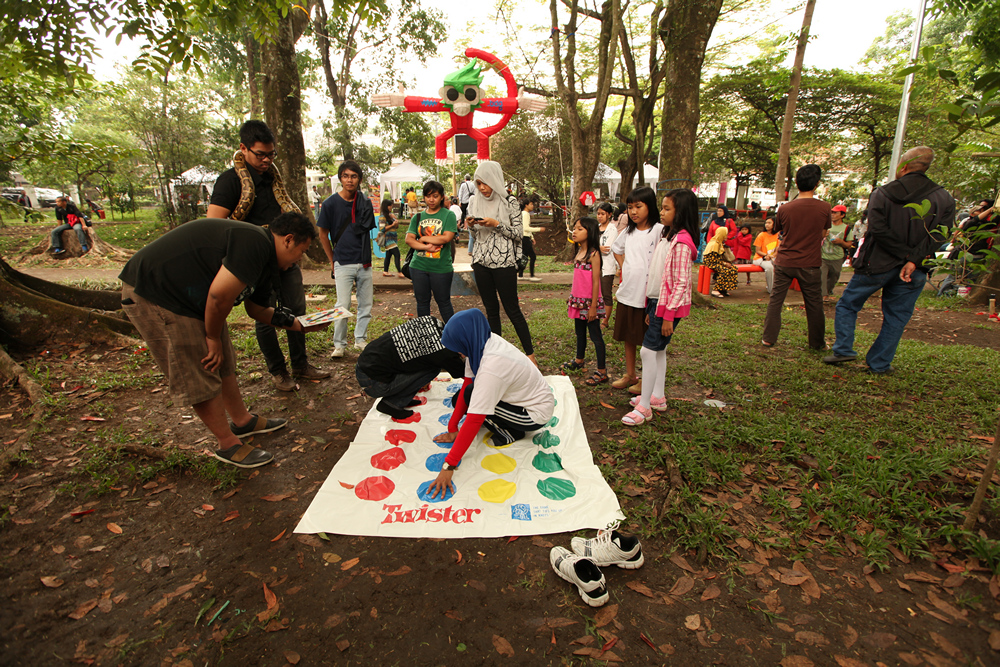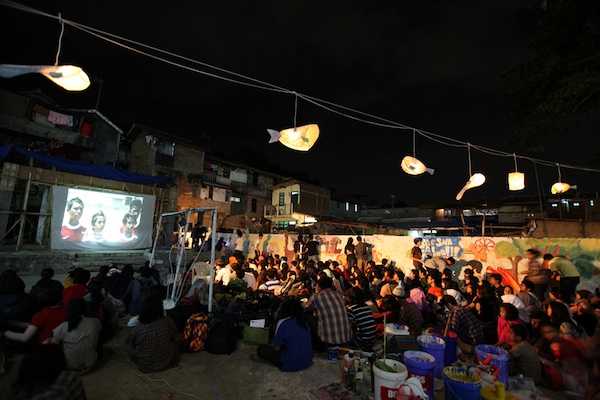Local design thinking in Bandung
Sybrand Zijlstra
Shortly before nightfall, the streets of Bandung undergo a remarkable transformation. Makeshift eateries are built up out of nowhere, often consisting of little more than a beat-up table and benches underneath a tarp held up by bamboo poles. Before long, people come in droves to eat simple meals while they are entertained by buskers.
By the next morning, everything has disappeared.
Pop-up restaurants and stores are a current trend in cities like New York and Sydney, celebrated for their quick response design style and ‘in the know’ marketing. In Indonesia, street food vendors are part of the grey economy and don’t officially exist. The people who run them have few rights, but they reflect an approach to design, through the arrangement of spaces, furniture and communications, that could be considered typically Indonesian.
All over the world, as organizations of all types grapple with the need to find attractive, effective, durable, human-centred solutions to complex problems, design is branching out under the name of design thinking. Design thinking means applying the methods and mind-set of designers in areas other than those normally reserved for design. There could be no better breeding ground than Indonesian society, which is full of citizen experts on adaptation to use, resourcefulness, scarcity, recycling, real needs, empowering people, etc. What is often perceived as a lack of discipline or lack of focus, can also be seen as an expression of the joy of letting things happen and responding to them – a fundamental joy of life combined with creativity and an open mind. These are in fact the tenets of design thinking.
In Bandung—where the term design action is preferred to design thinking—this has really taken off under the auspices of BCCF (Bandung Creative City Forum), an independent volunteers organisation co-founded and formerly led by Ridwan Kamil, now the mayor of Bandung. Since 2008, BCCF has served as a hub for the city’s creative communities. Its ‘urban acupuncture’ approach has attracted a lot of attention from policy makers in Indonesia and abroad. In the past couple of years, the group has been invited to present its methods and achievements in Berlin, Paris, London, Medellín, Chiang Mai, Jakarta, and many other places.
We consider design thinking as one of the methods that we can apply to come up with solutions that don’t require complicated bureaucracy, gigantic infrastructure, and massive financing. These are the kind of solutions that are feasible in the short-term, yet effective, although some might be temporary. – Tita Larasati, BCCF, General Secretary
Among many other activities, BCCF provides courses for budding entrepreneurs, organises street festivals, public discussions, and an international design thinking conference. It facilitates initiatives, and advises the local administration about potential urban solutions.
One of their programmes is called Kampung Kreatif, which aims to implement the idea of a creative city at the neighborhood level. It involves working with kampungs to find their own creative niche connected to specific local characteristics. Themes include food, art, craft, music and dance. The goals of Kampung Kreatif are to set up cottage industries, develop tourism, improve the local environment, and create a sense of community and pride.
Outdoor film screenings - Dwinita Larasati
An example is kampung Dago Pojok, located near the Dago waterfall in north Bandung. In 2003, local painter Rahmat Jabaril moved his studio to Dago Pojok and found poverty, tensions between youths, lack of education among adults, and neglected public space. In the years that followed, he started to give drawing lessons to young people from the neighborhood and reading and writing lessons to adults. He gained the trust of the locals and others joined him in organising activities with the goal of social change. Murals were painted to make the environment more lively and colorful, which had the added potential of attracting visitors as a way of generating income for the kampung dwellers.
In 2012, Rahmat Jabaril turned to BCCF for support. The activities already underway in Dago Pojok matched perfectly the ideas BCCF had for their Kampung Kreatif program. BCCF provided its network, helped find sponsorship and drew up a roadmap, making sure the Dago Pojok community was on board every step of the way. More and more people from the neighbourhood got involved, which led to more activities, such as a games festival, batik workshops, art exhibitions, free movie screenings, pencak silat (Indonesian martial arts) demonstrations, and a kampung guesthouse.
Unlike many officials in Indonesia, BCCF views people’s involvement in creatively shaping and improving their immediate environment as an asset rather than a nuisance. They work hard to move away from reproducing top-down solutions that require resources that may not be sustainable.
At first glance, design as a way to control processes and environments can seem to be incompatible with the Indonesian mentality that favours flow and improvisation. Is design in Indonesia a bad idea? Is it possible to ‘design’ in a climate that is characterised by continuous growth and decay?
The answers to these questions lie in the way design is understood. Design has its roots in the division of labor in industrial production processes: before production is started, detailed plans are laid out—much like a score or a script—that have to be executed to the letter. In an industrial setting this makes perfect sense.
In Indonesia, a reluctance to disrupt the flow makes other design approaches possible, even probable. Gamelan orchestras follow existing musical structures and patterns, but there is no score. Shadow puppet shows don’t follow a script but use known stories and adapt them on the spot, adding local and national characters to keep the stories alive and give them new meanings. Audiences behave accordingly. People come late, people leave early, they chat, they eat, they laugh and shout in response to what happens on stage. They become part of the performance, or more accurately the performance was never strictly separated from everyday life in the first place. Design in these contexts has more parallels with current global approaches to design than those that dominated the twentieth century.
The instant roadside restaurants lining the streets of Bandung at night demonstrate that a concerted effort goes a long way, creating constant flow in an impermanent environment and opportunities to make a living.
Sybrand Zijlstra (sybrand.zijlstra@gmail.com) is a freelance editor who lives and works in Bandung, writing on topics such as design and culture.













